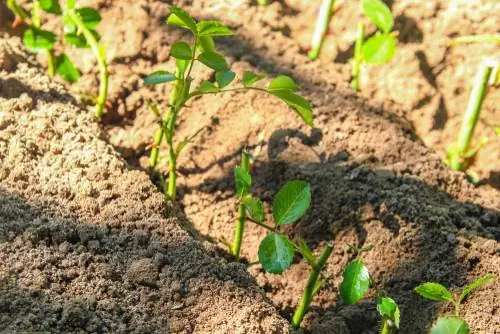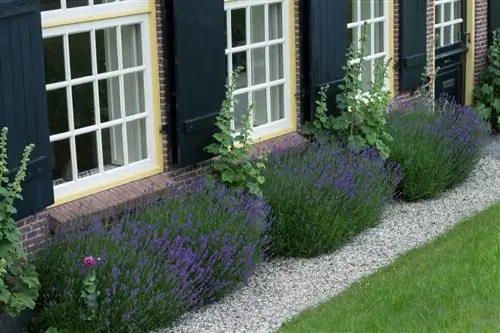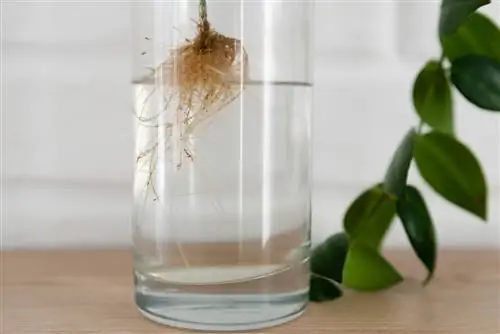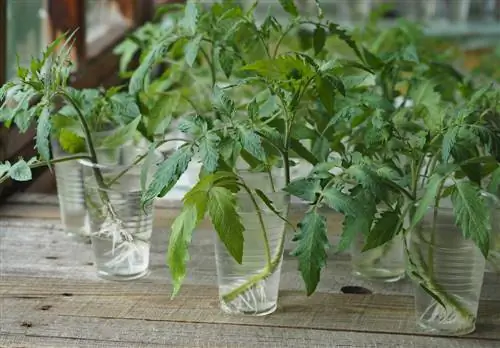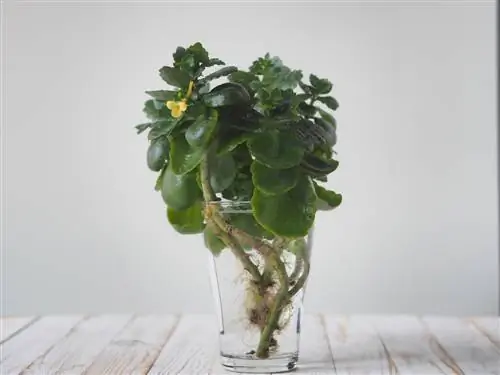- Author admin [email protected].
- Public 2023-12-16 16:46.
- Last modified 2025-01-23 11:22.
Rooting powder helps cuttings and freshly planted plants develop strong and he althy roots. Read this article to find out how to use this product correctly and what you should pay attention to.
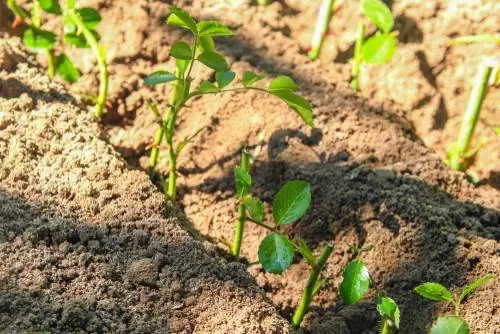
What do you use rooting powder for?
Rooting powder supports root formation in cuttings and young plants by providing natural growth hormones and nutrients. It promotes he althy, strong root growth, which leads to better water absorption and nutrient supply.
What is rooting powder?
Various agents are available commercially under the name “rooting powder” that are intended to have a positive effect on root growth. Natural growth hormones are used primarily in professional horticulture, which occur naturally in all plants and are responsible for cell division and cell growth. From a chemical point of view, these hormones belong to the group of auxins - the so-called growth regulators - and are intended not only to help roots develop more quickly, but also to significantly reduce the failure rate. After all, not all cuttings root, which in turn has an economic impact on businesses if there are high non-rooting rates.
The relevant plant hormones are the natural growth hormones
- Indole-3-acetic acid
- Indole-3-butyric acid
- and 1-naphthaleneacetic acid.
These are mixed with various solvents (e.g. alcohol) and fillers (e.g. talc) to make them usable. These root activators not only ensure that the roots grow at all, but also have an influence on their growth in thickness and length. Plants with strong roots are better supplied with water and nutrients, grow faster and more lushly and often need less fertilizer and irrigation water at their future location. Therefore, the use of growth hormones is beneficial for various reasons.
In the home garden, however, other root activators are usually used that do not require any artificial hormones. These are usually products obtained from algae, which also contain natural hormones to a lesser extent. These rooting powders also score points with additional nutrients and trace elements that promote he althy growth.
Excursus
Do rooting powders actually work?
Basically, rooting powders or root activators - after all, these products are not only available as powder, but also in liquid form or as a gel - provide growth advantages to plants treated with them. However, these remedies can fail on some cuttings or have little noticeable effect, which has various reasons. Not every plant “responds” to the treatment, especially since other factors play a major role in the successful rooting of cuttings. Incorrect use as well as an overdose also have fatal consequences: Both can lead to the plants not developing any or only a few roots.
What do you need rooting powder for?
As already mentioned, rooting powders are used primarily for propagating cuttings, although non-native and exotic species in particular often have difficulties with root development and therefore benefit from support. However, there are other areas of application where the rapid development of strong roots is important. This is the case, for example, when placing new plants in the bed or in a planter, especially if they are sensitive plants. There is already a rootstock here, but it has to be encouraged to take root - the faster this happens, the less stress the plant experiences and the quicker it puts its energy into above-ground growth.
Root activators are also suitable for use on plants grown from seeds, as they also promote germination and the development of seedlings. It is advantageous to choose agents that kill germs, as seedlings are often killed by fungal or other infections. However, if fungi, bacteria and viruses have no chance of spreading in advance, the young plants can develop undisturbed. It is best to read about the means that are suitable for this in the “Alternatives” section.
Seven attempts to get a “new” hydrangea? It hasn't worked for the last few years, now I've worked with rooting powder for the first time. I'm excited to see if anything happens! hydrangeas cuttings rooting powder garden gardenseason2019 sevenstrikes
A post shared by Große Gartenliebe (@grauer_alltag_in_farben) on Jun 30, 2019 at 9:47am PDT
Excursus
Which plants are particularly difficult to root?
You can tell whether a cutting is easy or difficult to root by looking at the mother plant. In general, robust and easy-care species develop roots very quickly and safely, while more capricious plants also have difficulty propagating. Many woody and non-hardy container plants - such as the various types of citrus - as well as camellias, roses and hydrangeas often benefit from the support of root activators.
Use rooting powder correctly
How you use the rooting powder correctly depends on various factors. Firstly, the dosage form is crucial for the type of application, as powder, tablets or gel each require a different approach. In addition, cuttings are treated differently than finished plants or young seedlings that are just ready to be used. Carefully read the respective manufacturer's instructions for use and adhere to their recommendations - especially when it comes to the dosage of the selected product.
You can usually use powdered root activators in four different ways:
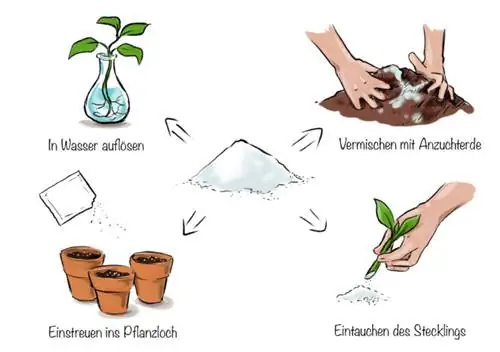
- Dissolve in water: Rooting powders dissolved in water are suitable for watering cuttings and already rooted plants, the latter of which can be treated with this agent both when planting and repotting.
- Mixing with potting soil: Instead of dissolving the powder in water, you can also mix it directly with the potting soil. Be sure to pay attention to the specific relationship between soil and root activator.
- Sprinkling into the planting hole: If you want to plant already rooted plants in the garden or in a planter, you can simply add the recommended amount of rooting powder as well as the starter fertilizer into the planting hole sprinkle.
- Dipping the cutting: When propagating cuttings, it is often advised to dip the interface of the cutting, which is later placed in the substrate, in rooting powder. Then shake the cutting very lightly and carefully so that only a thin film actually remains.
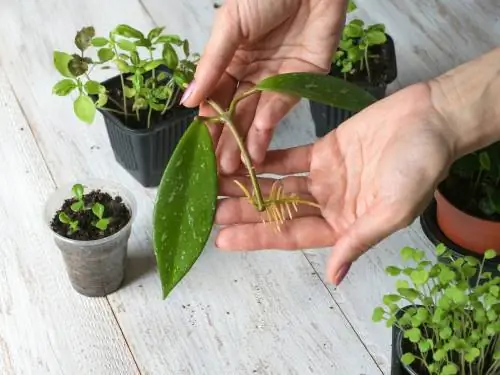
After treatment with rooting powder in water, the cutting is shaken slightly but not rinsed
Root activators in tablet or gel form, however, can be dissolved in water and used as a nutrient solution for cuttings or adult plants. These solutions do not last long, which is why you should always mix them fresh before each use and not leave them standing for a long time.
What alternatives are there to rooting powder?
Rooting powders based on growth hormones cannot be chemically recreated by laypeople, as you need a certain basic chemical education, an appropriate laboratory and the right ingredients - however, these are usually not available in pharmacies. But that doesn't matter, because there are a few alternatives that are also very effective and easy to obtain.
The best home remedies for better rooting
Why make it complicated when the following home remedies can make it much easier and, above all, cheaper?
Willow Water
Probably the best home remedy for rooting plants is willow water. Young willow branches contain large amounts of plant growth hormones (especially indole-3-butyric acid), and they are also rich in salicylic acid, which is effective against numerous pathogens and thus strengthens the resistance of the plants. And this is how you get the effective willow water:
- Cut young, pencil-thin willow branches - preferably in spring or early summer.
- Cut the branches into smaller pieces.
- In terms of quantity, you need two coffee cups of willow twig pulp for about three liters of water.
- Alternatively, you can also use willow bark, but you need at least three cups of it. The amounts of hormones are significantly lower in the older parts of the plant.
- Put the willow pieces into a sealable container.
- Pour freshly boiled water over them.
- Close the jar and let the mixture steep for 24 hours.
- Now strain the willow pieces and fill the broth into a glass bottle.
- The rooting solution is now ready to use and can be stored in the refrigerator for up to two months.
You can place cuttings to be rooted in the willow water for a few hours before planting or water them immediately afterwards.
This video shows you how propagation of rose cuttings works with the help of willow water:

Aspirin
Salicylic acid is not only found in willow branches, but also in the painkiller aspirin. This means you can use simple aspirin tablets to propagate plants just like willow water: Buy aspirin at the pharmacy and specifically ask for uncoated tablets. Dissolve one tablet per glass of water and use the resulting aspirin water to either water the plants or place the cuttings to be rooted in for a few hours before planting. By the way, unlike willow water, aspirin tablets do not contain any phytohormones - as plant growth hormones are also called - but are primarily effective against all kinds of pathogens and strengthen the young plants.
What else you need to pay attention to when propagating cuttings successfully
“Roots nourish us, invigorate us and bind us firmly to the earth. So plant them carefully.” (author unknown)
When propagating cuttings, it is not only the rooting agents used that determine success or failure, but above all the following factors:
- Season: Generally, cuttings should be taken in early summer as plants grow best at this time. In the fall or winter months, however, there is usually no point in trying to root plants. During this time, nature enters a period of rest and all growth stops.
- Substrate or water glass?: For rooting in the substrate, you should always use a germ-free and nutrient-poor growing substrate, as normal potting soil is too rich. However, if the cuttings are to be rooted in a glass of water (which does not work for all species), change the water daily.
- Plant part used: Not all cuttings are the same! Depending on the type of plant, you use different parts of the plant for propagation. Most species can be propagated using head or shoot cuttings, but others root better when using root sections, crack cuttings (here the cutting is not cut, but torn off), leaf cuttings (especially in thick-leaf plants and other water-storing leafy plants), offshoots or cuttings.
- Temperature and humidity: A warm (depending on the plant species between 20 and 25 °C) and bright, but not directly sunny location is also important for successful rooting. In addition, the humidity should be kept constantly high during the rooting period, for example in an indoor greenhouse (made yourself from a PET bottle).
Frequently asked questions
I read that cinnamon is also suitable as a rooting hormone. Is that true?
The spice is obtained from the bark of the cinnamon tree, but in this state it no longer contains any growth hormones. However, cinnamon works against fungi and other pathogens, which is why the powder is well suited for prevention and strengthening of cuttings. By the way, honey has the same effect, as long as it is real, untreated beekeeper's honey (and not the adulterated and chemically treated stuff from the supermarket).
You should put rose cuttings in a potato because then they will root faster. What's up with it?
In fact, rose cuttings root better if you first stick them in a fresh potato tuber and then plant them together. However, the method has a problem: If the tuber begins to rot, the cutting is also gone. In this case, willow water is less risky and also more effective.
My grandma claims that apple cider vinegar makes plants root faster. Is she right?
Apple cider vinegar, like cinnamon and honey, does not have a direct root-forming effect, but it reliably kills fungi and bacteria. The dosage is important here, because too much apple cider vinegar acidifies the substrate and deprives the plant of its livelihood - most plants need neutral to alkaline soil to thrive. Mix a teaspoon of vinegar until approx.a liter of water and dip the cuttings with the interface into it only briefly.
Tip
Place rooted cuttings - especially if you rooted them in a glass of water - into suitable planting substrate as quickly as possible. Otherwise, specimens transplanted too late will be hindered in their development and could weaken due to a lack of nutrients and become susceptible to infection.

